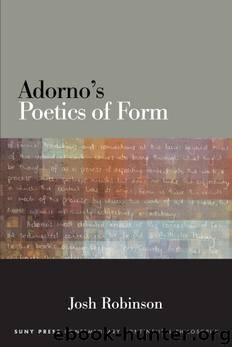Adorno's Poetics of Form by Josh Robinson

Author:Josh Robinson
Language: eng
Format: epub
Publisher: State University of New York Press
Published: 2018-04-14T16:00:00+00:00
Technique and the Mastery of Material
In the section of Aesthetic Theory entitled ‘Universal and Particular’, two consecutive paragraphs—‘Progress and the mastery of material’ and ‘“Technique”’—begin by making the same equation:
Without question, historical materials and their mastery—technique—progress; inventions such as perspective in painting, polyphony in music are the most obvious examples. (ÄT 313/AT 210)
The aesthetic name for the mastery of material—technique, borrowed from the ancient usage that counted the arts among the artisanal activities—is in its current meaning relatively new. (ÄT 316/AT 212−13)
Adorno’s conception of technique is clearly more specifically limited to the artistic sphere than the Greek τέχνη from which it is derived, which can refer equally to skill at a particular craft and to artistic capability. The term now ‘bears the traces of a phase in which, analogously to science, method appeared to be independent of its object’ (ÄT 316/AT 213). For Adorno, this independence is necessarily illusory, since art, as a means of resistance to the integration of all spheres of life into the capitalist economy, retains a connection to the medieval production of goods. As such, ‘under the technological aspect converge all artistic procedures that form material and let themselves be directed by it’ (ÄT 316/AT 213). Technique is thus not simply a means of processing artistic material according to a particular predetermined method, and Adorno’s ‘mastery of the material’ not a subjugation or even simply a domination of that which is to be incorporated into the artwork, but a more reciprocal capacity that consists at least in part in attentiveness to the limits and demands of the material.
This resounds with a claim made almost a decade earlier in the Introduction to the Sociology of Music:
Technique adjusts itself according to the state of the material and of the procedures. This state could be thought broadly comparable to the relations of production into which the composer is drawn, technique to the embodiment of developed productive forces, against which the composer verifies his own. Both are obedient to their mutual interdependence; the material is itself always a result of procedures, permeated with subjective moments; the procedures necessarily find themselves in a particular relation to their material, if they want to do justice to it. (EM 421/ISM 218)
Technique, that is, does not exist apart from the material which it works: the two must be seen as mutually interdependent. This pertains not only to the choice of the particular material of a specific work, but also, in the light of the discussion in the previous chapter of the tendencies represented by the Gesamtkunstwerk, to the particular medium, a concern which, as Bernstein has noted, ‘is hounded out of aesthetics and eventually art by the reigning concept of the concept, a concept cut loose from its moorings in materiality and sensible experience, the abstract concept whose appearances include the increasing dominance of technological reason and rationality’.11 It follows not only that technique and material are part of a conceptual constellation in which neither can be conceived without reference to the other, but also that they cannot wholly be separated from one another.
Download
This site does not store any files on its server. We only index and link to content provided by other sites. Please contact the content providers to delete copyright contents if any and email us, we'll remove relevant links or contents immediately.
The remains of the day by Kazuo Ishiguro(8814)
Tools of Titans by Timothy Ferriss(8211)
Giovanni's Room by James Baldwin(7188)
The Black Swan by Nassim Nicholas Taleb(7009)
Inner Engineering: A Yogi's Guide to Joy by Sadhguru(6722)
The Way of Zen by Alan W. Watts(6503)
Asking the Right Questions: A Guide to Critical Thinking by M. Neil Browne & Stuart M. Keeley(5629)
The Power of Now: A Guide to Spiritual Enlightenment by Eckhart Tolle(5603)
The Six Wives Of Henry VIII (WOMEN IN HISTORY) by Fraser Antonia(5394)
Astrophysics for People in a Hurry by Neil DeGrasse Tyson(5130)
Housekeeping by Marilynne Robinson(4328)
12 Rules for Life by Jordan B. Peterson(4249)
Double Down (Diary of a Wimpy Kid Book 11) by Jeff Kinney(4204)
The Ethical Slut by Janet W. Hardy(4172)
Skin in the Game by Nassim Nicholas Taleb(4161)
Ikigai by Héctor García & Francesc Miralles(4123)
The Art of Happiness by The Dalai Lama(4063)
Skin in the Game: Hidden Asymmetries in Daily Life by Nassim Nicholas Taleb(3929)
Walking by Henry David Thoreau(3892)
